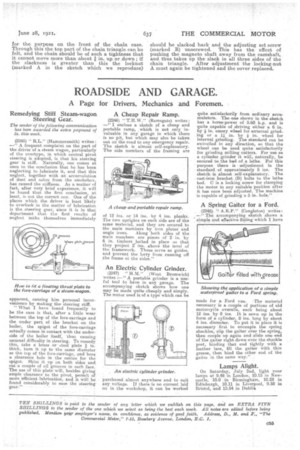ROADSIDE AND GARAGE.
Page 39

If you've noticed an error in this article please click here to report it so we can fix it.
Remedying Stiff Steam-wagon. Steering Gear.
The sender of the following communication has been awarded the extra payment of 5s. this week.
(2246) " R.L." (Hammersmith) writes : —" A frequent complaint on the part of the driver of a steam wagon, particularly of the overtype, in which central pivot steering is adopted, is that his steering gear is stiff. Natnrally, one comes at once to the conclusion that he has been neglecting to lubricate it, and that this neglect, together with an accumulation of dust and ashes from the smokebox, has caused the stiffness. As a matter of fact, after very brief experience, it will be found that the first conclusion at least, is not the correct one. One of the places which the driver is least likely to overlook in the matter of lubrication is the steering gear, since it is in that department that, the first results of neglect make themselves immediately
apparent, causing him personal inconvenience by making the steering stiff. " What. I have found frequently to be the case is that, after a little wear between the top of the fore-carriage and the under part of the bracket on the boiler, the spigot of the fore-carriage actually comes in contact with the underside of the boiler itself, thus causing unusual difficulty in steering. To remedy this, take a brass or steel plate in. thick, turn it up to the same diameter as the top of the fore-carriage, and bore a clearance hole in the centre for the spigot. Skim' it up on both sides and cut a couple of oil grooves in each face. The use of this plate will, besides giving ample clearance to the ,pivot, permit of more efficient lubrication, and it will be found considerably to ease the steering gear."
(2246) " T.H.W." (Ramsgate) writes: —" I enclose a sketch of a cheap and portable ramp, which is not only invaluable in any garage in which there is no pit, but which may also be taken out on the road to any emergency repair. The sketch is almost self-explanatory. The side members of the framing are
of 12 ins. or 14 ins. by 4 ins. planks. The two uprights on each side are of the same material, and they are secured to the main members by iron plates' and
angle irons. Along both sides of the main members are pieces of 2 in. by 6 in. timbers bolted in place so that they project 2ins, above the level of the framework. These serve as guides. and prevent the lorry from running off the frame at the sides."
An Electric Cylinder Grinder.
(2247) " R.M." (West Bromwich) writes :—" A portable grinder is a useful tool to have in any garage. The accompanying sketch shows how one may be made quite cheaply and simply. The motor used is of a type which can be
purchased almost anywhere and to suit any voltage. If there is no current laid on in the workshop, it can be worked
quite satisfactorily from ordinary accumulators. The one shown in the sketch has a horse-power of 0.60 hp. and is quite capable of driving either a 6 in. by in. emery wheel for external grind ing or a 11 in. by in. wheel for internal grinding. The standard can be swivelled in any direction, so that the wheel can be used quite satisfactorily for grinding milling cutters. For use as a cylinder grinder it will, naturally, be secured to the bad of a lathe. For this purpose there is adjustment in the standard of approximately 5 ins. The sketchis almost self-explanatory. The cast-iron bracket (B) bolts to the lathe bed. C is a locking screw for clamping the motor in any suitable position after it has once been adjusted. The machine is oapable of grinding a 5 in. hole,"
A -Spring Gaiter for a Ford.
(2248) " (Congleton) writes: —" The accompanying sketch shows a simple and effective fitting which I have
made for a Ford van. The material necessary is a couple of portions of old motorcycle overalls, each being about 12 ins. by 8 ins. It is sewn up in the form of a cylinder, 8 ins, long by about 4 ins. diameter. To put it in place it is necessary first to uncouple the spring shackles, slip the gaiter over the spring, then couple up again and slide one end of the gaiter right down over the shackle post, binding that end tightly with a loather lace, fill the gaiter with thin grease, then bind the other end of the gaiter in the same way."
Lamps Alight.
On Saturday, July 2nd, light your lamps at 9.48 in London, 10.15 in Newcastle, 10.0 in Birmingham, 10.28 in Edinburgh, 10.11 in Liverpool, 9.58 in Bristol, and 10.54 in Dublia








































